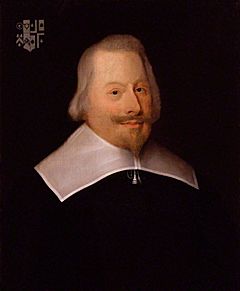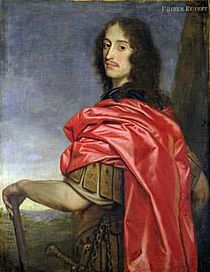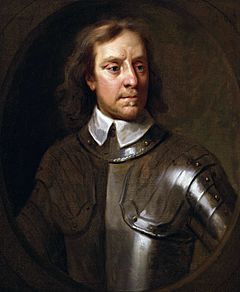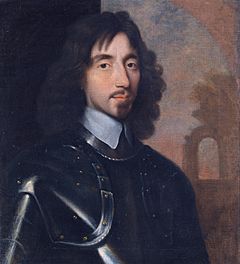First English Civil War facts for kids
Quick facts for kids First English Civil War |
|||||||
|---|---|---|---|---|---|---|---|
| Part of the Wars of the Three Kingdoms | |||||||
 The First English Civil War depicted in The Battle of Marston Moor, a painting by James Barker |
|||||||
|
|||||||
| Belligerents | |||||||
| Commanders and leaders | |||||||
|
|||||||
| Casualties and losses | |||||||
1642–1646
|
1642–1646
|
||||||
The First English Civil War was a big fight in England and Wales from 1642 to 1646. It was part of a larger series of conflicts called the Wars of the Three Kingdoms, which lasted from 1639 to 1653. These wars also included fights in Scotland and Ireland.
Many people were involved in these wars. About 15% to 20% of all adult men in England and Wales joined the military. Around 4% of everyone living there died because of the war. This shows how much the conflict affected ordinary people and how serious it was.
The main reasons for the war were disagreements between King Charles I and Parliament over who had the most power. They also argued about how people should practice their religion. These problems had been building up since 1603, when King James I became king. King Charles I tried to rule without Parliament for a long time, but he needed money. So, he called Parliament back in 1640. However, Parliament wanted more say in how the country was run, which the King didn't like.
At first, most people on both sides still believed in having a king. But they disagreed on who was truly in charge. The King's supporters, called Royalists, thought the King was above Parliament and the Church of England. Parliament's supporters, called Parliamentarians, believed the King should not control everything, especially religion. They wanted a constitutional monarchy, where the King's power was limited by laws. People often chose sides based on their religious beliefs or who they felt loyal to. Many people wanted to stay out of the war because they had seen how terrible the Thirty Years War was in Europe.
When the fighting started in August 1642, both sides thought it would end quickly after one big battle. But they were wrong. The Royalists had some success in 1643. This led Parliament to team up with the Scots. In 1644, the Parliamentarians and Scots won several battles, with the Battle of Marston Moor being the most important. Because some Parliamentarian leaders didn't follow up on these wins, Parliament created the New Model Army in 1645. This was England's first professional army, funded by the government. Their big win at the Battle of Naseby in June 1645 was a turning point. The war ended in June 1646 with Parliament winning and King Charles I being captured. However, the King refused to make agreements, which led to another war, the Second English Civil War, in 1648.
Contents
Why the War Started
The First English Civil War was one of several civil wars fought across England, Wales, Scotland, and Ireland between 1639 and 1653. These wars are known as the Wars of the Three Kingdoms.
The main reason for the war in England was a long fight for power between the King and Parliament. This struggle began when James I became king in 1603. Many of these issues were not truly settled until the Glorious Revolution in 1688.
Royalists vs. Parliamentarians
People often think of the two sides simply as Royalist Cavaliers and Parliamentarian Roundheads. While these names are still used, the real reasons people chose sides were much more complicated.
Choosing Sides: More Than Just Names
People's reasons for joining a side were complex. Many tried to stay neutral or fought only because they had to. Some even switched sides during the war! Historians say that by 1640, most people agreed that King Charles I had gone too far by trying to rule without Parliament.
Both sides claimed they wanted to bring back the "ancient constitution." For many Parliament supporters, the idea of kings having absolute power, brought in by James I, was new and had taken away traditional English freedoms. But even within Parliament, people disagreed on what these "rights" truly meant.
Most Parliamentarians in 1642 didn't want to get rid of the King. They just wanted to limit his power. Only a very small group wanted to end the monarchy completely. John Pym, a leader in Parliament, was one of the few who thought removing Charles might be the only way. This was because Charles had often broken his promises in the past. For example, he ignored the 1628 Petition of Right. He also made peace with the Scots in 1639 only to plan another war against them in 1640.
The King's Role and Religion
The King's personality and trustworthiness were very important. Most people believed a "well-ordered" monarchy was chosen by God. But they disagreed on what "well-ordered" meant and who had the final say, especially in religious matters. In the 1600s, people thought "true religion" and "good government" were the same thing.
Generally, Royalists supported a Church of England led by bishops, who were chosen by the King. Most Parliamentarians believed the King should answer to church leaders chosen by their local communities.

Religious Differences
It's a common mistake to think "Roundhead" meant "Puritan". A Puritan was anyone who wanted to "purify" the Church of England from "Papist" (Catholic-like) practices. This group had many different views. Most Puritans supported Parliament, but some, like Sir William Savile, stayed loyal to Charles.
Many Royalists also disliked some of the King's religious changes. They didn't like the appointment of Catholics to important positions. Parliamentarians were divided too. Some, like Pym, were Presbyterians who wanted to reform the Church of England. Others, called Independents, didn't want any state church at all. This group included Oliver Cromwell and many Baptists, who were common in the New Model Army.

The removal of bishops from Parliament in 1640 was a big step towards war. Bishops often blocked laws the King didn't like. Once they were gone, censorship ended. This led to many pamphlets and books being printed, some with very radical religious and political ideas. This worried some Parliamentarians who believed in a limited voting system and a Presbyterian church. These groups later saw the Independents as more dangerous than the Royalists. They formed the "Peace Party" to try and end the war through talks.
The War Begins: 1642
In late 1641 and early 1642, many towns got ready for war. They strengthened their defenses and bought weapons. When King Charles I left London in January 1642, Parliament gained control of the biggest city, port, and business center in England. They also got the largest weapons store in the Tower of London and the best local army, called the trained bands.
In March 1642, Parliament took control of the trained bands. Charles I responded by trying to raise his own armies. But Parliament controlled the two biggest weapons storage places in London and Kingston upon Hull.
Ports were super important for moving supplies. Most of the Royal Navy sided with Parliament. This allowed them to protect trade routes and stop Royalist supplies from coming in. By September, Parliament controlled almost every major port in England. This made it hard for Royalist areas to help each other.
King Charles Declares War
On June 1, 1642, Parliament gave King Charles a list of demands called the Nineteen Propositions. These would give Parliament control over who the King appointed, the army, and even his own household. Charles angrily rejected them.
Both sides thought one big battle would end the war. The Royalists wanted to capture London. Parliament wanted to "rescue" the King from his "bad advisors." After failing to take Hull in July, Charles declared war on Parliament on August 22. But his army was still small.

Parliament, with money from London and weapons from the Tower, raised an army of 20,000 men. This army was led by the Earl of Essex. On September 23, the first major fight happened at Powick Bridge. It was a small Royalist win, but it made Prince Rupert's cavalry famous.
The Royalist army grew to about 15,000, but many soldiers had only clubs or scythes. Parliament's army was better equipped but not well-trained. On October 23, the two armies fought a messy battle at Battle of Edgehill. Neither side won clearly. The Royalists then moved to Oxford, which became their capital for the rest of the war.
The War Continues: 1643
The year 1642 showed that the war would last a long time. The Royalists fortified Oxford. Parliament focused on holding the areas they already controlled. Both sides also tried to get help from Scotland and Ireland.
In the south-west, Royalist commander Sir Ralph Hopton won a battle at Braddock Down in January. In July, he defeated Parliament's army at Roundway Down. This was a big Royalist victory. Then, Prince Rupert captured Bristol on July 26. Bristol was the second-largest city in Britain and a key port for getting more soldiers from Ireland.
By late August, Parliament was in trouble. But John Pym's strong leadership helped them. In September, the Royalists planned a three-part attack. However, Parliament's army stopped Prince Rupert from taking Gloucester. They also checked his advance on London at the First Battle of Newbury on September 20. Royalist failures meant the war would not end soon.
Both sides looked for allies. Charles I made a truce with the Catholic Confederation in Ireland. This allowed him to bring Irish troops to England. But it made many Irish Protestants stop supporting him. Meanwhile, Parliament signed the Solemn League and Covenant with the Scots. This gave Parliament Scottish military help in exchange for money and a promise to create a single Presbyterian church for England and Scotland. This agreement caused new arguments within Parliament.
Turning Point: 1644
The agreement with Scotland created a Committee of Both Kingdoms to plan war strategy. In March, Parliament's army defeated the Royalists at Cheriton. Then, in April, the Earl of Manchester won at Selby. This forced the Royalists to defend York, which was then besieged by the Scots and Parliament's armies.
In May, Prince Rupert marched north, capturing Liverpool. On June 29, Prince Rupert arrived near York. On July 2, the two armies fought the biggest battle of the war at Marston Moor. This was a huge defeat for the Royalists, and they lost control of Northern England. York surrendered on July 16.
Later in the year, Parliament's army under the Earl of Essex was trapped in Cornwall at Lostwithiel. About 5,000 of his soldiers had to surrender. At the Second Battle of Newbury on October 27, the Royalists lifted a siege, and Charles I returned to Oxford.
By the end of 1644, the Royalists were struggling to pay for the war. Unlike Parliament, which could collect taxes from cities like London, the Royalists often just took supplies from the areas they controlled. This led to groups called Clubmen forming to protect their local communities from both sides.
The New Model Army
The deaths of John Pym and John Hampden in 1643 caused more divisions within Parliament. Some wanted a quick peace deal. Others, like Oliver Cromwell, deeply mistrusted Charles I. They believed only a military victory could achieve their goals. Many of these were religious Independents who didn't want any state church. They strongly disagreed with the Scottish demand for a unified Presbyterian church.

Because some commanders seemed unwilling to fight hard, Parliament decided to make changes. In December, they passed the Self-denying Ordinance. This meant that any military officers who were also in Parliament had to choose one job or the other. This removed some older, less effective commanders.
This led to the creation of the New Model Army. This was a professional army, paid by the government, and ready to fight anywhere. Many of its soldiers had fought with Cromwell before. To balance things, Parliament appointed Sir Thomas Fairfax as Commander-in-Chief. Cromwell was given command of the cavalry.
Decisive Year: 1645
In January, both sides tried to talk peace at Uxbridge, but they couldn't agree. This made the groups who wanted to keep fighting stronger. In early 1645, the Royalists still held much of Western England and Wales.
On May 31, Prince Rupert captured Leicester. In response, Sir Thomas Fairfax and the New Model Army attacked. On June 14, they won a huge victory at the Naseby. This defeat cost the Royalists their best army, their cannons, and even King Charles' private letters. These letters showed he was trying to get help from the Irish Catholic Confederation, the Pope, and France. Parliament published these letters, which really hurt the King's reputation.
After Naseby, the Royalists tried to hold onto their areas in Western England and Wales. Charles I hoped for 10,000 Irish Catholic troops to land in Bristol. But these hopes were unrealistic. The loss of Bristol on September 10 was a big blow. Charles I was so shocked he dismissed his nephew, Prince Rupert.
Cromwell's forces captured Royalist strongholds like Basing House and Winchester. Fairfax then began taking over the remaining Royalist areas in the west. When Charles' remaining cavalry were defeated at Rowton Heath on September 24, he gave up trying to reach Scotland. He returned to Newark. On October 13, he learned that his Scottish ally, Montrose, had been defeated a month earlier. This ended plans to take the war into Scotland. Charles I returned to Oxford, where he spent the winter surrounded by the New Model Army.
The End of the First War: 1646
By December 1645, the Royalists held only a few areas. Chester surrendered in February 1646. The last major battle of the war happened at Stow-on-the-Wold on March 21.
After capturing Exeter and Barnstaple in April, the New Model Army marched on Oxford. On April 27, King Charles left Oxford in disguise. On May 6, Parliament learned that the Scottish army had him in custody near Newark. Newark surrendered that same day, and the Scots took the King north to Newcastle. Parliament was very angry and ordered the Scots to leave England.
Oxford surrendered on June 24. The remaining Royalist strongholds also fell, though Harlech Castle in Wales held out until March 1647. This marked the end of the First English Civil War.
What Happened Next
In 1642, many Parliamentarians thought that if they beat the King in battle, he would agree to their terms. But they were wrong about Charles I. He believed that God would not let "rebels and traitors" win. This strong belief meant he refused to make any real agreements, which frustrated both his allies and his enemies.
Charles I was right that most people still supported the idea of having a king. But he didn't understand how much his constant delays and broken promises had hurt his standing. He had made peace with the Scots in 1639, then raised an army against them in 1640. Before the war, his actions convinced Parliament that he would use any money they gave him against them. After the Royalist defeat in 1646, he kept negotiating separately with many different groups.
This led to a powerful group emerging who believed Charles would never agree to a fair political solution. This group, often called 'Independents', controlled the New Model Army. They felt they had to force a solution. Even though Sir Thomas Fairfax was a Presbyterian and initially respected the King, he supported the army's actions.
Charles continued to stall, which made everyone, especially the New Model Army soldiers, very frustrated. Many soldiers hadn't been paid for over a year and wanted to go home. By March 1647, the King owed them a huge amount of money. Some in Parliament wanted to send the army to Ireland to get rid of them. But the soldiers refused to leave without being paid. This tension contributed to the start of the Second English Civil War in 1648.
Images for kids
-
'Cavalier Troops Mustering outside the Guildhall, Exeter' by John Joseph Barker, 1886, from the Royal Albert Memorial Museum's collection




